Everything in your garden even gardening jokes and happy stories......



Beautiful, thanks for sharing.

Celia - I too love Gerberas, a dear friend bought me a beautiful bunch wrapped in purple cellophane the other day, they were bright pink also.

Thank you both, yes they are pretty but wish they had a fragrance.

My DIL used gerberas for her wedding bouquet and theme. Lovely splash of colour.


Yes RnR they do make a lovely splash of colour. The cake looks good too!

LOVE THIS IDEA!! We should be doing this all over Australia:
Farm It Forward is an urban farming social enterprise model connecting landowners and local young people who are passionate about growing food. The project develops skills and creates training and job opportunities, while tackling social isolation and giving meaning to life, issues for young and old, isolated and less mobile people.
How Farm it Forward Works:In exchange for allowing their land to be used for market gardening, landowners :Receive a weekly box of fresh organically grown veggies, grown on their own property or on other land in the project.
Are visited weekly by working groups of young people to establish and maintain organic food production, and enhance cross-generational connections.
Have the opportunity to be a part of a community or organic food growers through social media, gatherings and visitation to the large garden plots operated by Farm it Forward
The regular help groups allow for new aspiring growers to identify their passion and use the program as a career pathway.
All excess produce is sold to local cafes, restaurants and the local food co-operatives which support the project.
https://www.farmitforward.com.au/

How to make your own Indigenous herbs and spices rack
 Australia is packed with native herbs and spices - and they may be more accessible than you think. (Gayle and Mike Quarmby/Instagram)
Australia is packed with native herbs and spices - and they may be more accessible than you think. (Gayle and Mike Quarmby/Instagram)  Australia is packed with native herbs and spices - and they may be more accessible than you think. Swap out your paprika and dried parsley. Push imported spice bottles to the side and reap the flavour rewards.
Australia is packed with native herbs and spices - and they may be more accessible than you think. Swap out your paprika and dried parsley. Push imported spice bottles to the side and reap the flavour rewards.
https://www.sbs.com.au/food/article/2020/10/20/how-make-your-own-indigenous-herbs-and-spices-rack

I went further and further into a site and forgot where I was! LOL
But I came back to this that looks yummy Incognito.
Thanks for sharing, must admit some of those looked like I had pulled out in the garden during the week. Are these commercial exported and sent to the cities?
Quandong, riberry, macadamia & wattleseed tart PinterestYummlyFacebookTwitterEmailShare
PinterestYummlyFacebookTwitterEmailShare

Whilst walking through the backstreets of Marrickville I noticed a couple of trees studded with bright pink fruit. I knew immediately what they were. Most were under or overripe but I still managed to pick a big handful from the branches. I just can’t help myself. They either get eaten by insects and birds or simply fall to the ground and dry up. What a waste of riberries!
I knew there was a pack of quandongs already awaiting a recipe in the freezer, so pocketing some fresh riberries was a good idea. Why not make a tart?
There’s nothing new about a frangipane tart but loading it with native Australian fruit sets it apart from the norm, and adding some ground wattleseed and macadamias to the mix gives it another firm Aussie stamp.





Quandong, riberry, macadamia & wattleseed tartShowcasing some of the beautiful native edibles unique to Australia. CourseDessert CuisineNative Australian & Foraging Servings servingsINGREDIENTSPastry225 g plain flour75 g caster sugar115 g butter chilled1 egg beaten1 egg yolk beaten60 ml cold waterFilling125 g unsalted butter100 g caster sugar1 tsp vanilla paste2 eggs150 g macadamia nuts ground1 tbsp wattleseeds toasted & finely ground50 g riberries50 g quandongs INSTRUCTIONSPastryPlace the flour, sugar and butter into the bowl of a food processor and pulse until granulated. With the motor still running, add the eggs. Add the water a little at a time until the mixture comes together to form a ball. Turn off, remove the dough and form into a ball. Wrap in cling film and refrigerate for 1 hour. Alternatively rub the butter into the flour and sugar, then add the eggs and water, mixing with your hands.Preheat oven to 200°C.Roll out the dough to line a 25 cm tart tin. Lay the dough into the tin and gently press into the edges and corners. Bake blind for 10 minutes, remove the paper and weights and bake for a further 10 minutes. Remove from the oven and allow to cool.Reduce oven temperature to 180°C.FillingBeat the butter, sugar and vanilla until light and creamy. Add one of the eggs and beat really well before adding the next, beating again. Stir through the macadamias and wattleseeds until incorporated. Spoon the frangipane mixture into the tart shell and spread evenly.Cut the riberries in half to remove the seed, if there is one. Stud the riberries and quandongs onto the frangipane and press down slightly. Bake for 30-40 minutes or until light and golden on top, and cooked through.Allow to rest for 10 minutes before removing from the tin. Can be served warm or at room temperature, dusted in icing sugar. Double or clotted cream or ice cream is a must.RECIPE NOTES
INSTRUCTIONSPastryPlace the flour, sugar and butter into the bowl of a food processor and pulse until granulated. With the motor still running, add the eggs. Add the water a little at a time until the mixture comes together to form a ball. Turn off, remove the dough and form into a ball. Wrap in cling film and refrigerate for 1 hour. Alternatively rub the butter into the flour and sugar, then add the eggs and water, mixing with your hands.Preheat oven to 200°C.Roll out the dough to line a 25 cm tart tin. Lay the dough into the tin and gently press into the edges and corners. Bake blind for 10 minutes, remove the paper and weights and bake for a further 10 minutes. Remove from the oven and allow to cool.Reduce oven temperature to 180°C.FillingBeat the butter, sugar and vanilla until light and creamy. Add one of the eggs and beat really well before adding the next, beating again. Stir through the macadamias and wattleseeds until incorporated. Spoon the frangipane mixture into the tart shell and spread evenly.Cut the riberries in half to remove the seed, if there is one. Stud the riberries and quandongs onto the frangipane and press down slightly. Bake for 30-40 minutes or until light and golden on top, and cooked through.Allow to rest for 10 minutes before removing from the tin. Can be served warm or at room temperature, dusted in icing sugar. Double or clotted cream or ice cream is a must.RECIPE NOTES
If you're going out foraging be 100% certain that what you're picking is edible. When in doubt, don't pick it - or consult an expert.
SHARE THIS RECIPE

Not the sort of thing I would eat, but it is great they are using some Indigenous fruits.

How to nurture your own bush food garden  Having your own Indigenous bushfood garden at home can benefit your cooking, wellbeing, and local biodiversity. (Christian Hampson)
Having your own Indigenous bushfood garden at home can benefit your cooking, wellbeing, and local biodiversity. (Christian Hampson) 

 Hide Grid IMAGE 1/ VIDEO AUDIOYerrabingin cofounder Christian Hampson shares what produce he grows in his Sydney courtyard and how you can do the same.By Samantha van Egmond
Hide Grid IMAGE 1/ VIDEO AUDIOYerrabingin cofounder Christian Hampson shares what produce he grows in his Sydney courtyard and how you can do the same.By Samantha van Egmond
9 NOV 2020 - 12:38 PM UPDATED 9 NOV 2020 - 1:42 PM
Indigenous Australian ingredients have been part of our First Nation's diet for generations. However, in recent years we've seen the country's bush foods appear more and more on restaurant plates and cooking shows.
Aside from the fact they're a hardy bunch that have long been adapted to our climate, Australia's bush foods are packed with nutrition and flavour.
If you're thinking about growing your own bush foods garden, luckily it's easy and requires minimal space.
GROWING YOUR OWN BOTANICALS
 Australia's first Indigenous rooftop farm is not just about bushfoodThis Indigenous-run enterprise in Sydney's inner-city suburb of Eveleigh is a community gem.
Australia's first Indigenous rooftop farm is not just about bushfoodThis Indigenous-run enterprise in Sydney's inner-city suburb of Eveleigh is a community gem.
Christian Hampson, the cofounder of Indigenous social enterprise Yerrabingin, had a handful of bush foods growing in pots at his townhouse in Sydney's inner south when COVID-19 struck - but he and his partner thought they should have more. Nine months later, they have 20 pots across two courtyards. Hampson says, "One courtyard is shaded while the other has lots of sun, so we can have a variance of species.
He thinks before COVID, many people weren't cooking as much because they were travelling to work. "But with more time to make meals at home, they might be thinking about where to find the freshest produce, and growing their own."
If you're thinking to create your own bush-food garden too, Hampson suggests planting a few flowering natives alongside edibles to nurture the environment and attract pollinators.
"What a lot of people might not realise in the city is that even four or five pots on every balcony is adding to the biodiversity," he says.

Christian Hampson is the co-founder of Indigenous social enterprise start-up Yerrabingin, which maintains a rooftop native garden.
Start with saltbushIf you're new to gardening, Hampson recommends the silvery and robust saltbush. "Saltbushes are really good for people who struggle with plants as they're very easy to look after," he says. "They're also perfect for those who are only growing herbs, as you can simply combine them with your normal herb garden."
Hampson says saltbush works particularly well with Asian cooking – Kylie Kwong uses it in several of her dishes – though the leaves tend to have a strong chlorophyll taste and are best when dehydrated or heavily cooked.
"I would normally fry them before baking with fish," he says. "You can use it in lots of different ways, and you don't need to add salt because it has that strong salt flavour," says Hampson.
YOU HEARD IT HERE FIRST
 Kylie Kwong’s top tips for using Australian bush food in Asian cookingAustralia's bush foods are a brilliant match for Asian cooking.
Kylie Kwong’s top tips for using Australian bush food in Asian cookingAustralia's bush foods are a brilliant match for Asian cooking.Grow some warrigal greens
For fresh and nutritious salads, Hampson advises planting some antioxidant-rich warrigal greens. "They're a native spinach that grow very easily, you'll probably want to have them contained as they can really take off," explains Hampson. "They are highly resilient and are found in coastal areas of Australia that get a lot of salt, sun and heat."
Hampson suggests keeping warrigal greens in a planter and cutting them back regularly. "Warrigal greens have massive amounts of vitamin C, however, they're high in oxalates, [which can lead to kidney stones in some people] so blanch them well before eating," says Hampson. "They have quite a peppery taste and make an awesome pesto."
DIY
 How to make your own Indigenous herbs and spices rackSwap out your paprika and dried parsley. Push imported spice bottles to the side and reap the flavour rewards.
How to make your own Indigenous herbs and spices rackSwap out your paprika and dried parsley. Push imported spice bottles to the side and reap the flavour rewards.Myrtle and midgenberry
Most of us are familiar with lemon myrtle, while cinnamon and curry myrtles are lesser-known culinary varieties. "Fully grown, they're a four or five-metre tree, but contained to a large pot you'll get a decent-sized bush," says Hampson, who loves the strong flavour of lemon myrtle and uses it to make a syrup for cocktails and cordials. "One bushel can make a few litres," he says.
Also a member of the myrtaceae family, the midgenberry makes a flavourful and attractive addition to a any garden.
"It grows blueberry-sized berries that are speckled like a quail’s egg," says Hampson. "They're quite delicate, but the plant itself is very hardy."
Hampson describes the midgenberry as having a "cinnamon latte" taste, and its fruit is often used in preserves and sauces. "They're also really nice to eat straight off the bush," says Hampson.
FOR GOOD REASON
 Indigenous ingredients take chargeFrom lemon myrtle to mountain pepper - there's so much to uncover and marvel over right on our doorstep.
Indigenous ingredients take chargeFrom lemon myrtle to mountain pepper - there's so much to uncover and marvel over right on our doorstep.Shade vs sun
Hampson says his Davidson plums love the shady side of his house. "They also don't mind living indoors, just be careful the air con isn't too crazy as it can dry them out," he says. But Hampson notes that they'll need to go outdoors from time to time for pollinating.
For your home's sunnier spots, try a finger lime – typical citrus: they like plenty of water – while areas of dappled sun are ideal for a macadamia tree. "I've got one in a pot and I've tried it on both sides; they're a forest species but they don't mind some sun," says Hampson. "Just be mindful of reflective heat from concrete in courtyards and balconies."

Hampson gets his plants from IndigiGrow, an Indigenous social enterprise at La Perouse in Sydney's south east.
Hampson says the relationship between growing plants and eating not only aids cooking but supports mental health. He adds it can also help generate a better understanding of the cultures of our First Peoples.
"It can make you get off your computer and water your garden, and maybe think about what you can trim off to add to your dinner that evening," says Hampson. "It can also be a great connector for people who want to understand Indigenous culture."

Hoping this will inspire gardeners to plant some Indigenous plants, it has me, going to see if I can get at least one from the nursery next time I visit.

This morning my back garden was dug up of all its annuals thanks to a moth catterpillar!
Had been spraying it for three weeks both hubby and I, but nothing worked so a friend and I got into the Lobelia and all the plants it loved to eat and pulled them all out. Including the bright orange Calendula that I have grown from seed.
The catterpillers were dark, the markings made them look as if they had big eyes!
Anyway they loved the damp parts of the garden and now it has been removed; shall not water those areas and let them dry out so they will then get sprayed.
Heart breaking to pull out healthy chewed up plants that were pretty.

Depends what you are using to spray, chemical sprays often unbalance the nature of things, might need to go to Yates website and ask or look up a natural remedy, I have heard garlic and chilli sprays work. Maybe insects are becoming immune to the sprays too.

Identify the caterpillars
Australia has over 10,000 species of caterpillars, which have been divided into about 100 families on the basis of similar DNA.
Each family is divided into a number of genera which contain a number of related species.
Although the caterpillars of many moth species are rather similar to each other, some caterpillars are easy to identify because they have some unique characteristic, so can be identified to the individual species, some can only be identified to the family, or a group of families, and some beasties look like caterpillars but are not true caterpillars at all.
Most insect taxonomy has been performed using the adult forms, so usually the only sure way to determine the species of a caterpillar is to rear it through to the adult butterfly or moth, and then identify that, but some caterpillars do have particular characteristics which can help classify or even identify them :
http://lepidoptera.butterflyhouse.com.au/faqs/ident.html
Do not spray
Cover your vegie patch up
.... some important species may be dependent on them.

Yes!
How ever the Moth/Butterfly came to visit after we had pulled it all out it was interesting she went to each section of the garden beds where the Blue Lobelia had been! There was nothing there just soil so she was familiar with the garden bed.
The Lobelia was self seeded it was matted and long, so whatever it was sprayed would not have penatrated the compact plants and there were lots of them, they made a nice splash of colour!

Army worms.
This is what the garden has still, but we have killed a high number of them but it will be an on going issuel
https://www.myhometurf.com.au/lawn-tips/army-worms/

Wow they can do some damage (checked out the link, very interesting)

Picked my first strawberry for the season!!

The case for growing your own avocados (by Robin Gale-Baker)
Have you ever considered that when you buy an avocado you could be supporting a Mexican criminal cartel or supporting water rights in Chile that are resulting in thousands of small farmers being effectively deprived of their livelihoods?
Mexico is the biggest producer of avocados in the world, having a perfect climate for production. The industry has, however, apparently been controlled by cartels since the late 1990s. Avocados have become a new conflict commodity, much like conflict diamonds, as cartels illegally log, clear land and murder small farmers.
Chile is the 14th largest producer of avocados in the world. Chilean economists in 1981 adopted an ‘American’ water rights system (much like the Australian one) that has left smaller farmers asking the world to stop buying Chilean avocados. These farmers are not getting a water allocation at all and, not only are they going broke, but they are also unable to use their land for anything else.
What better argument could there be for purchasing local food or growing your own?
Avocados are tropical trees which do well in warm, humid climates with little temperature variation. Sudden drops in temperature and frosts are very damaging to the fruit.
There are, however, varieties that can grow in temperate zones such as ours. Wurtz ‘A’ Type is one. This grafted ‘dwarf’ grows to 4 metres in height and 6 metres in width. It has a weeping habit, medium sized fruit and can be pruned down to 2 metres. It flowers and fruits from November to February but takes at least 3 years to produce. It is partially self-fertile but will fruit better if a type B cultivar is planted nearby (e.g. Bacon, Fuerte or Sharwill).
[Editor's note: when an avocado flower blooms, it does so with either its female reproductive parts available or its male reproductive parts available, but not both. With the Type A varieties, the female parts tend to be available in the mornings, with the male parts then becoming available in the afternoons (with the female parts becoming unavailable). With Type B varieties, it is the other way round. This process is 'designed' to hinder self-fertilisation.]
Wurtz can be grown in a large pot (75-100 litres). This is often a good way to grow an avocado as it means that in winter, when the tree needs protection from frost, it can be moved to a sheltered spot. Alternatively, build a semicircular mud brick wall around it and the thermal mass of the mud brick will keep it free from frost damage.
Avocados are shallow rooted and have a weak root system. They are best grown on a large mound or a slope as they need to be well drained. They also need plenty of water (it takes about 68 litres of water to produce one avocado in tropical climates, a bit less in temperate ones). They are easily stressed by dryness, windburn or sunburn and (unusually) like being watered in the middle of the day. Trunks can be protected from sunburn with whitewash. Stake the tree to prevent breakage or loosening from the soil in wind.
On our clay soils, it is best to add gypsum, compost and well rotted cow manure and some blood and bone to the soil, and build a high, wide mound. Then mulch it well to keep moisture in the mound but keep the mulch away from the trunk to prevent collar rot.
Avocados are climacteric, meaning that they ripen off the tree. Once an avocado has reached full size, twist it from the branch and let ripen it for 2 weeks. If it does not shrivel, then the fruit is ready and all can be harvested or some left on the tree for later use.


Nice, might have to get some ready for my mum, she would love them, thanks Celia.

Hi Incognito! Does your mum enjoy gardening or just looking at flowers? These Portulaca certainly make a good show of colour, but they like the sun, they close up when the sun gets on them. But they are pretty hardy that is for sure. Another flower/plant that I put in some areas of the garden that are suitable and like similar conditons are the Vinas.
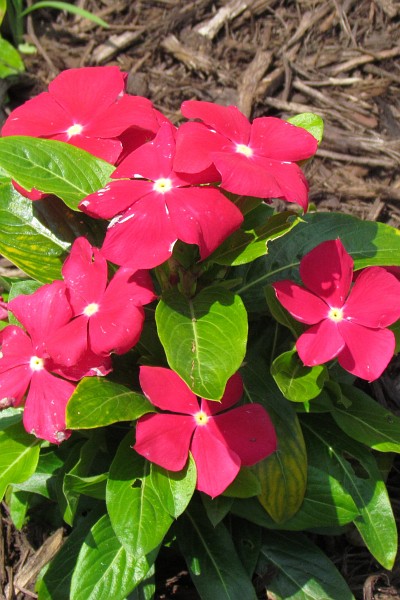
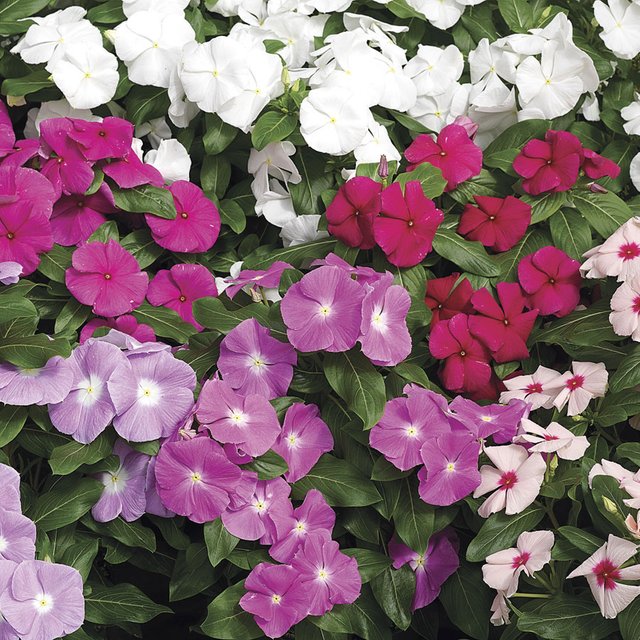
Nature Photography by Richard L. Bowman - Flower Blog (edtechbybowman.net)

Mum still does gardening, does a bit at a time and then has a rest in between. I am actually going to buy her a new watering can so will look out for these flowers too and pot some up for her if I can find them but she also loves natives too, so depends on prices and availability in the next couple of weeks.
Thanks Celia,love our flowers.

Hi Incognito! Does your mum enjoy gardening or just looking at flowers? These Portulaca certainly make a good show of colour, but they like the sun, they close up when the sun gets on them. But they are pretty hardy that is for sure. Another flower/plant that I put in some areas of the garden that are suitable and like similar conditons are the Vinas.


Nature Photography by Richard L. Bowman - Flower Blog (edtechbybowman.net)

Keeping plants happy is easy with our new Chameleon Card
26 November 2020
<i aria-hidden="true"> 3 minute read
The Chameleon Card – a plant’s best friend.
How does saving water and a booming veggie patch sound? It’s difficult to know how often to give growing veggies a drink and how much to give at one time. Many crops get too much water at the early stages and then too little when they are big. This results in poor yields.
We have developed new technology – now available via the Virtual Irrigation Academy – that makes it possible for backyard green thumbs and the world’s most disadvantaged farmers alike to give their plants the right amount of water.
It’s called the Chameleon soil water sensor. It’s an electronic device that provides gardeners and farmers with information to simultaneously save water and boost their crop yields.
Chameleon Card colours the path to crop successOur researcher Dr Richard Stirzaker originally developed the Chameleon in 2016. It was created to assist farmers in developing countries to conserve water and improve food security.
“Millions of people irrigate to grow food but do not have simple and accurate information to guide them. The Chameleon uses coloured lights to tell you when to irrigate,” Richard said.
“It’s something that everyone can understand. Farmers using Chameleon sensors quickly changed their practices, many using less water to achieve higher yields.”
Since then many thousands of Chameleon sensors have gone into the ground helping farmers in over 15 countries.
Buried soil moisture sensors connect to a Chameleon card and detect soil moisture levels. The card then displays the data on an incredibly easy to understand readout in the form of one of three colours:
a green light means there is just enough water in the soil: you will need to water in the next day or so to ensure soil moisture levels remain just righta red light means there is too little soil moisture: your crop needs watera blue light means there is enough soil moisture: don’t water the crop!So, what can it achieve? Well, farmers using the Chameleon in countries like Tanzania and Malawi have reported increases to their crop yields of over 50 per cent, while using up to 33 per cent less water.
More food, using less water? Yes please!
Dr Richard Stirzaker (left) demonstrating the Chameleon Card to former Wallaby’s player David Pocock.
A chameleon changes more than its coloursOver time, the Chameleon has been refined. The latest version (called the Chameleon Card) is the size of a credit card.
The good news is the technology is now available to purchase in Australia for home gardeners and farmers.
People who purchase the Chameleon Card are joining a global community who are learning to grow more food with less water and helping to further our research.
If you’ve got an itch for gardening or a loved one who can’t keep a plant alive to save themselves, the Chameleon Card might just be the ticket to a healthier garden. So, how about a Chameleon Christmas Card?
Not sure about this and they start at $99, think it is cheaper to use the index finger lol

Merry Christmas to all gardeners on here.


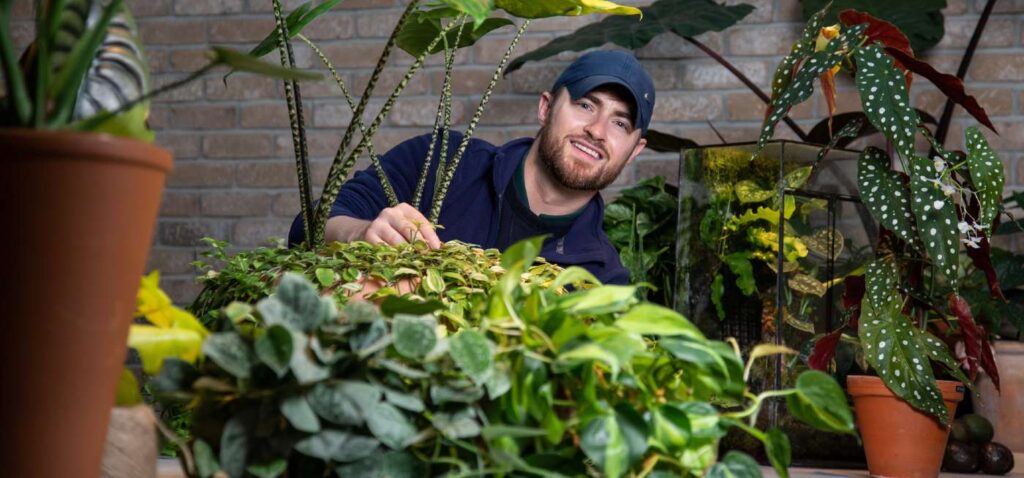
A green-thumbed Brit has grown the ultimate collection of house plants, including a species worth $15,500 a leaf.
30-year-old Tony Le-Britton turned his lounge into a jungle and transformed his spare room into an incredible greenhouse to nurture his passion.
He has collected some of the world’s rarest plants—including one previously thought to have been extinct.
And Tony, from Gloucestershire, England is now hawking the leaves of another rare species for thousands of dollars per leaf to eager collectors.
He’s not only good at grooming plants, he is a top hair and beauty photographer professionally.
His prized possession? That’d be the Rhaphidophora Tetrasperma Variegata—the most valuable species in his collection.
“The non-variegated plant is really common—you can pick it up in most supermarkets and garden centers,” Tony said. “But my version, a genetic mutation—it’s completely random, which makes it rare. It’s the only one in the world [with that leaf pattern].”
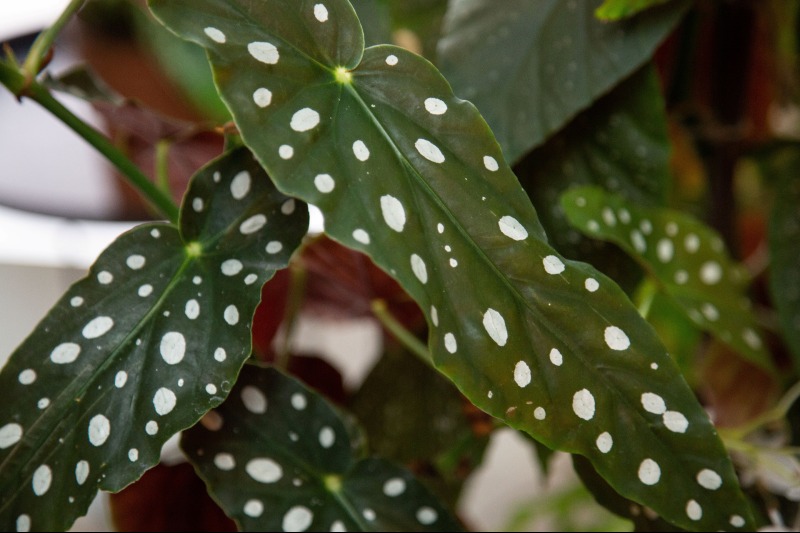
“I have already taken three pre-orders at £12,000 each, per leaf. There’s a waiting list. I have had so many people contacting me. It’s like growing money on trees!”
Tony is also the proud owner of a Monastera sp Bolivia—which is currently undocumented by science.
“It’s from a botanical collector in Austria. I got it as a very small piece of stem. It’s grown to huge proportions.”
“I put a picture online and a botanist in the field in Bolivia got in touch with me asking for more pictures—he had no record of the plant.”
“The only way to find out what it truly is is to find it in the wild. Using the stem and leaf, we can then identify the family it belongs to.”
A Begonia Chloristica, an exotic plant previously thought to have been lost in the wild, also has a special place in Tony’s greenhouse.
According to Tony, it was thought to be extinct up until a couple of years ago—and he found one from a collector in Europe.
Tony credits his interest in plants to his grandparents, who would take him to their garden when he was a small boy.
He also remembers sitting at his grandmother’s feet and watching the popular BBC television show ‘Gardener’s World’.
CHECK OUT: Englishman Grows 500 Types of Edible Foods With Only a Few Hours’ Work a Month
Tony said his grandmother Cora was known in the local area for her plant collection—which he has tried to emulate.
Stunning pictures now show the results of more than two decades of care—with two of his rooms filled with hundreds of plants.
“It just stuck with me—I grew up in the garden. It’s all about the experiences I had when I was younger with my grandparents.”
RELATED: Compassionate Neighbor Subs in to Help Soldier’s Son With Yard Work
“People always admired [Cora’s] garden, and she made me a part of that. It’s in my blood I suppose.
He didn’t study plants formally, but a quarter century of growing teaches you a lot.
“You learn to just let plants get on with it. I think some people can overcare for their plants.
He sets aside maybe three hours every three weeks, cutting off dead leaves, checking the roots, and watering them.
“The greenhouse is temperature, humidity and light controlled, so I can check everything is well on my phone. It really doesn’t take a lot.
“I do go in there every day—but that’s because I enjoy it”.
Tony regularly post pictures to his 29,000 followers on Instagram, where he is the envy of the plant world.
<iframe src="https://www.instagram.com/p/CGhF5J0gvj6/embed/captioned/?cr=1&v=13&wp=485&rd=https%3A%2F%2Fwww.goodnewsnetwork.org&rp=%2Fuk-man-grows-plants-worth-15000-a-leaf%2F%3Futm_campaign%3Dnewsletters%26utm_medium%3Dweekly_mailout%26utm_source%3D22-12-2020#%7B%22ci%22%3A0%2C%22os%22%3A18363.999999999578%2C%22ls%22%3A16718.989999999394%2C%22le%22%3A16834.999999999127%7D" allowtransparency="true" allowfullscreen="true" frameborder="0" height="1230" data-instgrm-payload-id="instagram-media-payload-0" scrolling="no" data-gtm-yt-inspected-1_25="true"></iframe>The ‘Gardener’s World’ television show has even been in touch about doing an episode from his house, which he described as life coming “full circle”.
Tony has never worked out the total cost of his collection—but guessed that it be could be significant: “From an insurance point of view, it’s definitely added to the value. It’s probably worth more than some houses!
MORE: City is Converting Highway Pillars into Vertical Gardens to Clean the Air
“But I have this collection of incredibly rare plants that, from the outside, nobody would ever guess—and I love that.”
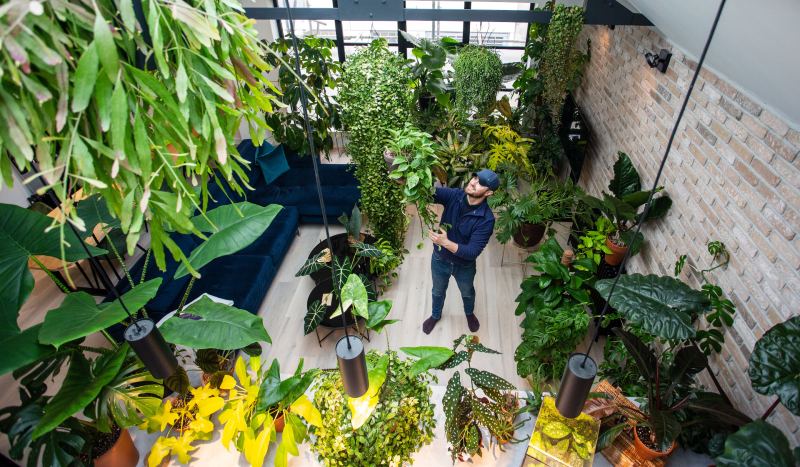






They are nice in a vase.